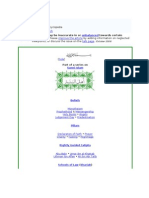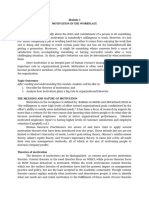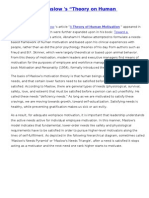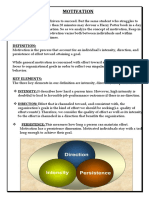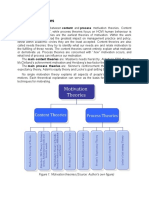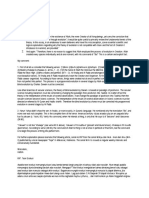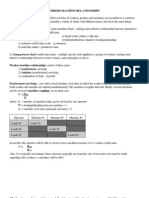Ma Slow
Ma Slow
Uploaded by
Mohamad Shuhmy ShuibCopyright:
Available Formats
Ma Slow
Ma Slow
Uploaded by
Mohamad Shuhmy ShuibCopyright
Available Formats
Share this document
Did you find this document useful?
Is this content inappropriate?
Copyright:
Available Formats
Ma Slow
Ma Slow
Uploaded by
Mohamad Shuhmy ShuibCopyright:
Available Formats
Chapter 9
Maslow's Hierarchy Of Needs
One of the best known theories explaining the actions of people is that of Dr.
Abraham Mallow (Motivation and Personality, New York, Harper & Row, 1954). Dr.
Mallow hypothesized that people are motivated by a hierarchy of needs. When low-
level needs are satisfied, individuals are no longer motivated by them. As each level
of needs is met, individuals progress to higher level motivators. Here is Maslow's
hierarchy.
1. Physiological-the need for food, clothing, and shelter.
2. Security and safety-the need to be free from physical danger and to be secure in
the feeling that physiological needs can be met.
3. Social-the need to be loved, to be accepted, and to belong.
4. Ego-the need to be heard, to be appreciated, and to be wanted.
5. Self-actualizing-the need to achieve one's fullest potential.
In relation to persuasion and sales techniques, how does Maslow's theory apply? In
trying to persuade someone to change a belief or to perform an action, successful
communicators often rely, intentionally and unintentionally, on appeals to an
individual's needs.
Most Americans no longer worry about their physiological, security, and safety
needs. Fortunately, our culture and society are so advanced that these basic, low-
level needs no longer motivate our actions, although the needs are always present.
If we are hungry, we will respond to advertised food appeals that might otherwise
be ignored.
On the other hand, to the extent that our society is out of synch with the actualizind
status. How do you respond when someone says that you have done a good job?
What would you think of being given an impressive work title instead of a salary
increase?
At the highest level are self-actualizing needs. People seek to achieve their highest
potential through professional, philanthropic, political, educational, and artistic
channels. These needs, according to Maslow's concept, become important only
when all social and ego needs have been satisfied.
In applying Maslow's theory to persuasive appeals, you must
1. Decide which appeal would be most effective for the intended receiver. This may
mean predicting the needs level of your receiver at the time of your persuasive
effort.
2. Shape a message that capitalizes on the receiver's needs.
3. Persuade the receiver that the desired action would satisfy those needs.
Analyze some of the sales messages you have received. To what needs do they
appeal?
Mary Ellen Guffey, Instructor's Manual, Essentials of Business Communication,
South-Western College Publishing, 1995.
You might also like
- Maslow's Hierarchy of Needs: Gain vital insights into how to motivate peopleFrom EverandMaslow's Hierarchy of Needs: Gain vital insights into how to motivate peopleRating: 5 out of 5 stars5/5 (5)
- Stages in A Gestalt Therapy SessionDocument5 pagesStages in A Gestalt Therapy Sessionjolieoana100% (6)
- WahhabiDocument11 pagesWahhabiMohamad Shuhmy Shuib100% (1)
- Practical Guide To UETA AND ESIGN 2002 - INCLUDES SPECIAL SECTION ON CALIFORNIA LAWSDocument130 pagesPractical Guide To UETA AND ESIGN 2002 - INCLUDES SPECIAL SECTION ON CALIFORNIA LAWS83jjmackNo ratings yet
- Maslow's Hierarchy Theory: Needs), and The Top Level Is Known As Growth or Being Needs (B-Needs)Document12 pagesMaslow's Hierarchy Theory: Needs), and The Top Level Is Known As Growth or Being Needs (B-Needs)Suresh Kutty MNo ratings yet
- Felicity Marie Gargar BSN 1 AbrahamDocument5 pagesFelicity Marie Gargar BSN 1 AbrahamFelicity MarieNo ratings yet
- HRM Maslow's Hierarchy of Needs ExplainedDocument4 pagesHRM Maslow's Hierarchy of Needs ExplainedVillaruz Shereen MaeNo ratings yet
- Chapter 6 Process Premises EditDocument17 pagesChapter 6 Process Premises EditAssad RiesreshaNo ratings yet
- Eship - Unit 2 NotesDocument14 pagesEship - Unit 2 Notesthegodhimself05No ratings yet
- Unit 2 Consumer As An IndividualDocument17 pagesUnit 2 Consumer As An IndividualRuhit SKNo ratings yet
- OB Ch-4Document48 pagesOB Ch-4Asegid gezehagnNo ratings yet
- Theories of MotivationDocument8 pagesTheories of Motivationjunayed_sustNo ratings yet
- MaslowDocument3 pagesMaslowSerena AboNo ratings yet
- Chapter 6 MotivationDocument16 pagesChapter 6 MotivationYosef TsegayeNo ratings yet
- Theories of MotivationDocument12 pagesTheories of MotivationIyke Jacob GraitsNo ratings yet
- Chapter 5 - Motivation in The WorkplaceDocument20 pagesChapter 5 - Motivation in The WorkplaceTrixxie mae MontelloNo ratings yet
- 5565-Marketing Management Solved 2009Document16 pages5565-Marketing Management Solved 2009usmanusmanNo ratings yet
- The Sixth Commandment: Setting Standards Rewarding PerformanceDocument9 pagesThe Sixth Commandment: Setting Standards Rewarding PerformanceDavid 'Valiant' OnyangoNo ratings yet
- Motivation MGT HW Nasrin RahmatiDocument3 pagesMotivation MGT HW Nasrin Rahmatinasirin rahmtiNo ratings yet
- HRDocument15 pagesHRnur akmaNo ratings yet
- Consumer BehaviourDocument2 pagesConsumer BehaviourmyraNo ratings yet
- Maslows TheoryDocument9 pagesMaslows TheoryPratik ThakkarNo ratings yet
- What Maslow's Hierarchy Won't Tell You About MotivationDocument5 pagesWhat Maslow's Hierarchy Won't Tell You About Motivationgunn RastogiNo ratings yet
- MotivationDocument24 pagesMotivationizmakhanNo ratings yet
- Maslow Hierarchy of NeedsDocument4 pagesMaslow Hierarchy of NeedsMalak Kinaan88% (8)
- MaslowDocument10 pagesMaslowchapter 1No ratings yet
- Theories of Motivation: 1) Contribution of Robert OwenDocument13 pagesTheories of Motivation: 1) Contribution of Robert OwenluminitarusuNo ratings yet
- 6501 2Document25 pages6501 2NizamuddeenNo ratings yet
- Name: Anne Princess Aquino Section: Chapter 5: MotivationDocument1 pageName: Anne Princess Aquino Section: Chapter 5: MotivationCess AquinoNo ratings yet
- Module 7 HandoutsDocument11 pagesModule 7 HandoutsMa. Rosa mayoresNo ratings yet
- Motivation TheoryDocument10 pagesMotivation TheoryJananee RajagopalanNo ratings yet
- Maslow's Hierarchy of NeedsDocument6 pagesMaslow's Hierarchy of Needsimdad ullahNo ratings yet
- MaslowDocument2 pagesMaslowFatima Ezzahra BencheqrounNo ratings yet
- MotivationDocument14 pagesMotivationMudassir HanifNo ratings yet
- Lecture 42Document19 pagesLecture 42faisal waleedNo ratings yet
- Imagine A Workplace Where Everyone Did What You Needed Them To DoDocument4 pagesImagine A Workplace Where Everyone Did What You Needed Them To Dochapter 1No ratings yet
- UNIT 2 Integrated Advertising Program CHAPTER 5Document30 pagesUNIT 2 Integrated Advertising Program CHAPTER 5chotudxNo ratings yet
- BUSI 1628 Final ExamDocument10 pagesBUSI 1628 Final Examtraquang2004No ratings yet
- UntitledDocument13 pagesUntitledIme RaaphorstNo ratings yet
- Esteem Needs: Truth Justice Wisdom MeaningDocument3 pagesEsteem Needs: Truth Justice Wisdom MeaningAnuraj AroraNo ratings yet
- What Is Motivation?Document13 pagesWhat Is Motivation?Sushobhita RathNo ratings yet
- CHP 1,2,4,5Document91 pagesCHP 1,2,4,5Sarthak RautNo ratings yet
- Needs and Wants of Human PDFDocument6 pagesNeeds and Wants of Human PDFjayhanne bagniNo ratings yet
- Theories of MotivationsDocument10 pagesTheories of Motivationss_shakilNo ratings yet
- Motivation Theories: Figure 1. Motivation Theories (Source: Author's Own Figure)Document22 pagesMotivation Theories: Figure 1. Motivation Theories (Source: Author's Own Figure)jovilyn briosoNo ratings yet
- Assignment On MotiavtionDocument14 pagesAssignment On MotiavtionMd Salahuddin SakibNo ratings yet
- Maslow's Theory of Motivation - Hierarchy of NeedsDocument5 pagesMaslow's Theory of Motivation - Hierarchy of NeedsVinay NayakNo ratings yet
- Maslow's Hierarchy of Needs: Theories Research Methods Academic Skills A-Level StatisticsDocument13 pagesMaslow's Hierarchy of Needs: Theories Research Methods Academic Skills A-Level StatisticsStevecia LukaNo ratings yet
- Soft Skill Final 8 TH SemDocument45 pagesSoft Skill Final 8 TH SemJyotirmoy MahataNo ratings yet
- Goal Theory - Reward & MotivationDocument2 pagesGoal Theory - Reward & Motivationkerang73No ratings yet
- Maslow's Hierarchy of NeedsDocument33 pagesMaslow's Hierarchy of NeedsAndrew PamhareNo ratings yet
- What Is Maslow's Hierarchy of Needs?Document3 pagesWhat Is Maslow's Hierarchy of Needs?Yuzar StuffNo ratings yet
- Motivation 2Document30 pagesMotivation 2aysha farihaNo ratings yet
- 9 What Maslow's Hierarchy Won't Tell You About MotivationDocument4 pages9 What Maslow's Hierarchy Won't Tell You About Motivationk61.2215115252No ratings yet
- Assignment On Maslow's Hierarchy of NeedsDocument5 pagesAssignment On Maslow's Hierarchy of NeedsTwasin WaresNo ratings yet
- Maslows HierarchyDocument4 pagesMaslows HierarchyLissie ArcherNo ratings yet
- Strategic Product Brand Management - Incomplete NotesDocument21 pagesStrategic Product Brand Management - Incomplete NotesNaman MaheshwariNo ratings yet
- Module 2 Motivation NotesDocument20 pagesModule 2 Motivation Notesrahul rameshNo ratings yet
- MC&OB Unit 4Document17 pagesMC&OB Unit 4Tanya MalviyaNo ratings yet
- MODULE 11 - Week 4 - The Child and Adolescent Learners and Learning PrinciplesDocument10 pagesMODULE 11 - Week 4 - The Child and Adolescent Learners and Learning PrinciplesMarsha MGNo ratings yet
- Human Relations TheoriesDocument28 pagesHuman Relations TheoriesHarold100% (1)
- Chapter 5 Motivation in The WorkplaceDocument18 pagesChapter 5 Motivation in The WorkplaceAshlley Nicole VillaranNo ratings yet
- Reaching Your Potential: How Self-Love Is the Key to Unlocking Your GreatnessFrom EverandReaching Your Potential: How Self-Love Is the Key to Unlocking Your GreatnessNo ratings yet
- Teori EvolusiDocument3 pagesTeori EvolusiMohamad Shuhmy ShuibNo ratings yet
- Eap8 Abraham MaslowDocument9 pagesEap8 Abraham MaslowMohamad Shuhmy ShuibNo ratings yet
- Met A Cognition 1Document5 pagesMet A Cognition 1Mohamad Shuhmy ShuibNo ratings yet
- A World Where Womanhood Reigns Supreme (The Seeds of My Own Re-Evaluations)Document3 pagesA World Where Womanhood Reigns Supreme (The Seeds of My Own Re-Evaluations)Mohamad Shuhmy ShuibNo ratings yet
- Men Get Honor in JannahDocument8 pagesMen Get Honor in JannahMohamad Shuhmy ShuibNo ratings yet
- Edward de Bono CoRT Thinking ProgrammeDocument27 pagesEdward de Bono CoRT Thinking ProgrammeRanitha MohananNo ratings yet
- What Are The 21 Eras Matron Personality TraitsDocument3 pagesWhat Are The 21 Eras Matron Personality TraitsMohamad Shuhmy ShuibNo ratings yet
- Human Resource Management SystemDocument10 pagesHuman Resource Management SystembalamuraliNo ratings yet
- CoRT Thinking LessonsDocument7 pagesCoRT Thinking LessonsMohamad Shuhmy ShuibNo ratings yet
- Bagaimana Membudaya Kerja Cemerlang Dan Berektika Bagaimana Membudaya Kerja Cemerlang Dan BerektikaDocument15 pagesBagaimana Membudaya Kerja Cemerlang Dan Berektika Bagaimana Membudaya Kerja Cemerlang Dan BerektikaMohamad Shuhmy ShuibNo ratings yet
- Zina The Easy OptionDocument5 pagesZina The Easy OptionMohamad Shuhmy Shuib100% (1)
- I Want To Repent But....Document5 pagesI Want To Repent But....Mohamad Shuhmy ShuibNo ratings yet
- Indicators For Decision MakingDocument39 pagesIndicators For Decision MakingMohamad Shuhmy ShuibNo ratings yet
- Public RelationDocument4 pagesPublic RelationMohamad Shuhmy Shuib67% (3)
- Interpersonal Communication Theories and ConceptsDocument5 pagesInterpersonal Communication Theories and ConceptsMohamad Shuhmy ShuibNo ratings yet
- Interpersonal TheoryDocument4 pagesInterpersonal TheoryMohamad Shuhmy Shuib100% (1)
- CommunicationsDocument11 pagesCommunicationsMohamad Shuhmy Shuib100% (2)
- Met A CognitionDocument12 pagesMet A CognitionGuru Khb PblNo ratings yet
- Bengkel KesetiausahaanDocument2 pagesBengkel KesetiausahaanMohamad Shuhmy ShuibNo ratings yet
- CoRT Thinking LessonsDocument6 pagesCoRT Thinking LessonsMohamad Shuhmy Shuib100% (2)
- Edward de Bono CoRT Thinking ProgrammeDocument27 pagesEdward de Bono CoRT Thinking ProgrammeRanitha MohananNo ratings yet
- PG Diploma in Procurement & Contracts Management BrochureDocument4 pagesPG Diploma in Procurement & Contracts Management BrochureTariq AkhtarNo ratings yet
- Aurora Alcantara-Daus vs. Sps. HermosoDocument2 pagesAurora Alcantara-Daus vs. Sps. Hermosoamareia yapNo ratings yet
- PMBOK 7th Edition - ENG-6Document5 pagesPMBOK 7th Edition - ENG-6Felipe Guimaraes Pazin0% (2)
- Dividend Policy of Everest Bank Limited: A Thesis Proposal byDocument9 pagesDividend Policy of Everest Bank Limited: A Thesis Proposal byRam khadkaNo ratings yet
- CashewDocument15 pagesCashewpwd001No ratings yet
- NATWESTDocument25 pagesNATWESTfaguobaozhuangfa2No ratings yet
- A Quality Risk Management Approach For Qualification and CommissioningDocument5 pagesA Quality Risk Management Approach For Qualification and CommissioningAngel Ramón GutiérrezNo ratings yet
- Section V - Contract Adminstration Procedures Major BuildingsDocument13 pagesSection V - Contract Adminstration Procedures Major BuildingsAyodele Oluwaseyi DinaNo ratings yet
- Day BookDocument3 pagesDay BookPreeti GargNo ratings yet
- 1 - Software Quality Assurance ConceptsDocument50 pages1 - Software Quality Assurance ConceptsMuhammad IbrarNo ratings yet
- UOP E Assignments - ECO 561 Final Exam Answers FreeDocument15 pagesUOP E Assignments - ECO 561 Final Exam Answers Freeuopeassignments100% (1)
- SKF India 05.2023Document8 pagesSKF India 05.2023sunny.manjani1No ratings yet
- Airbus Boeing PresentationDocument52 pagesAirbus Boeing PresentationMohamed HefnyNo ratings yet
- Transportation + LPPDocument2 pagesTransportation + LPPrinku_6181No ratings yet
- Conquering The Chaos PDFDocument3 pagesConquering The Chaos PDFHemant Sudhir WavhalNo ratings yet
- Amc AgreementDocument7 pagesAmc AgreementbjaideepNo ratings yet
- Company+insight Posts - Page 10Document8 pagesCompany+insight Posts - Page 10geniusmarketinggal07No ratings yet
- Additional Mathematics Project Work 2024Document12 pagesAdditional Mathematics Project Work 2024thivyajayanthinairNo ratings yet
- As 60695.11.21-2006 Fire Hazard Testing Test Flames - 500 W Vertical Flame Test Method For Tubular PolymericDocument8 pagesAs 60695.11.21-2006 Fire Hazard Testing Test Flames - 500 W Vertical Flame Test Method For Tubular PolymericSAI Global - APACNo ratings yet
- Man MachDocument5 pagesMan MachLovely RainNo ratings yet
- Szabist: (Shaheed Zulfikar Ali Bhutto Institute of Science & Technology)Document5 pagesSzabist: (Shaheed Zulfikar Ali Bhutto Institute of Science & Technology)IRFAN KARIMNo ratings yet
- Chap 5-Elasticity and Its ApplicationDocument40 pagesChap 5-Elasticity and Its ApplicationKhánh AnNo ratings yet
- How To Develop The Business Concept: Robert H. HackerDocument23 pagesHow To Develop The Business Concept: Robert H. Hackerapi-25978665No ratings yet
- Membership Brochure M4 FinalDocument12 pagesMembership Brochure M4 FinalDuc PhanNo ratings yet
- Exclusion From Gross IncomeDocument7 pagesExclusion From Gross Incomeanon_310411008100% (4)
- Layout and Location of AUTOMOBILE INDUSTRIESDocument6 pagesLayout and Location of AUTOMOBILE INDUSTRIESVineet Raj Goel100% (1)
- Social Control and Nationalization of Banks:An Evaluative AnalysisDocument16 pagesSocial Control and Nationalization of Banks:An Evaluative AnalysisDebayan N SenNo ratings yet
- Oracle20140506 DLDocument68 pagesOracle20140506 DLjenriquezvNo ratings yet
- The Impact of Financial Leverage To Profitability Study of Vehicle Companies From PakistanDocument21 pagesThe Impact of Financial Leverage To Profitability Study of Vehicle Companies From PakistanAhmad Ali100% (1)


